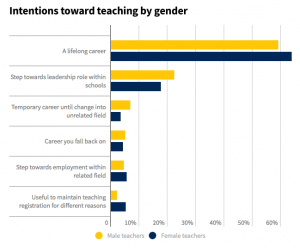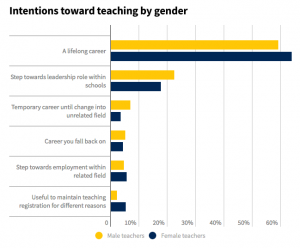Kai Glennie didn’t enjoy any of his classes, had trouble making friends and dreaded going to school every morning.
But soon after he turned 10, he decided to spend the rest of his life in the classroom, as a teacher.
“School didn’t engage me at all and I struggled a lot until one particular teacher in year 5 changed my whole outlook,” said Mr Glennie, 20, who is in his second year of a primary education degree at the Australian Catholic University (ACU) in Sydney.
“Ms Jenkins gave everyone individual attention and made each student feel welcome. It made me want to give other kids the same experience I had.”
Talking to his favourite teachers in high school also pushed Mr Glennie towards the profession.
“A lot of my teachers have said how much of a rewarding experience it is seeing their students thrive and progress, and I’ve always seen how my teachers have helped me progress,” he said.
“I also had a few really good ones in high school who showed me how great male teachers can be.”
While the “intrinsic” value of teaching and the ability to teach are the top reasons both men and women go into the profession, a new study has found that men are also very likely to go into teaching because they are interested in a particular subject.
This is the third biggest reason male teachers enter the profession, while shaping children’s future and making a social contribution are the third largest motivators for female teachers, according to the survey of more than 1000 teachers.
Other motivators for both male and female teachers include prior teaching and learning experiences and job security.
“The report shows us males are attracted to teaching when they have the opportunity to teach a specialisation or have the opportunity for progress,” said Professor Claire Wyatt-Smith, lead author of the study conducted by ACU’s Learning Sciences Institute Australia in partnership with the Queensland College of Teachers.
 “We have shortages in a number of areas including English, maths and science,” Professor Wyatt-Smith said.
“We have shortages in a number of areas including English, maths and science,” Professor Wyatt-Smith said.
“Looking at who studies what subjects, this could be a way for us to solve those shortages, too. We can recruit males into science and maths and promote that into teaching.”
The study found that using the data on motivating factors to get more men into teaching could be one way to address the country’s “looming teacher drought”.
Only one in four teachers across the country are male and the proportion of men in the profession has been steadily falling since 1984.
Meanwhile, student numbers are expected to grow by 26 per cent by 2022 while overall teacher numbers have grown by an average of 1 per cent in the past five years.
As well as attracting teachers, retaining them in the classroom is a major issue for policymakers, Professor Wyatt-Smith said.
About 59 per cent of male teachers and 64 per cent of female teachers see teaching as a lifelong career, the study found.
 More than 22 per cent of men see classroom teaching as a step towards leadership roles in schools, 6.8 per cent see it as a temporary career until they move into another field and 5.1 per cent see it as a fallback career.
More than 22 per cent of men see classroom teaching as a step towards leadership roles in schools, 6.8 per cent see it as a temporary career until they move into another field and 5.1 per cent see it as a fallback career.
About 17.6 per cent of female teachers see it as a step towards leadership roles, 5.5 per cent see it as a step towards a different role in a related field and 4.2 per cent see it as a fallback career.
A separate study recently found that up to half of all Australian teachers were leaving the profession within the first five years.
“It’s concerning,” Professor Wyatt-Smith said. “More recognition of high-quality teachers [is needed] for them to continue their work in the classroom rather than step out into administrative positions.
“We need to attract them and retain them. We clearly need to look at the transition from university into classroom practice and we need a far more effective induction phase when they enter schools.”

